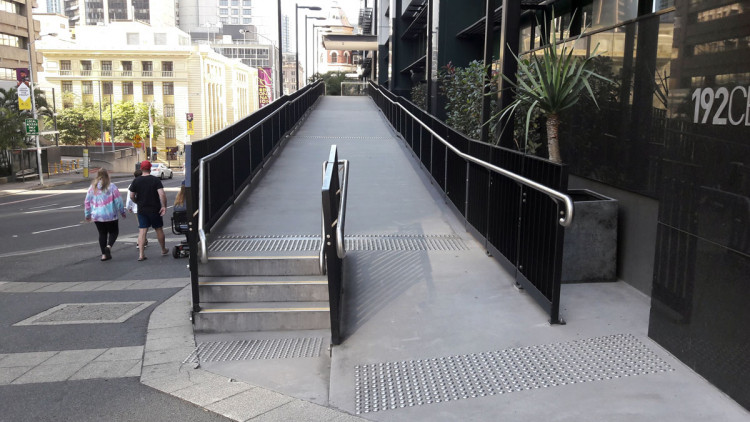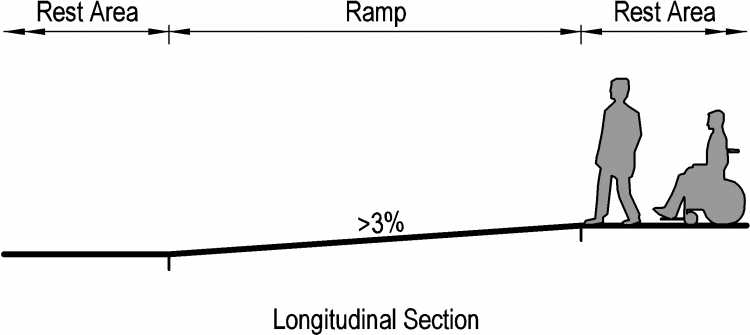Steps are good for reducing the distance pedestrians have to walk in areas with steep terrain (compared to a switchback ramp), but are a barrier to people with impaired mobility. There should be a step-free option wherever steps are provided.
A footpath through zone should be treated as a ramp if the mean gradient is greater than five percent. A maximum gradient of 1:14 (7%) should be used wherever achievable but a ramp shall not be steeper than 1:12 (8%). Note rest areas are required where the mean gradient exceeds three percent for over 18 metres as shown below.
Note that shared paths should be treated carefully, as frequent rest areas can be uncomfortable and destabilising for wheeled users.

A zig-zag ramp with regular rest areas – SH36 in Tauranga. (Photo: Bridget Burdett)
The table below has key design features common to both ramps and steps on footpaths.
Table: Design features common to both ramps and steps
|
Feature |
Purpose |
Location |
Design issues |
|||||
|
Landing |
Accommodates changes of direction after the ascent/ descent is completed. Ensures that pedestrians emerging from the ramp/steps are clearly visible to others. |
Top and bottom of every ramp or flight of steps. |
At least 1.2m long, 1.8m preferred. Extends over the full width of the ramp/steps. Kept clear of all obstructions. Gradient should be less than 2%. |
|||||
|
High contrast material |
To enable people to detect the top and bottom of the ramp/ steps. |
Edge of the landings, adjacent to the ramp/steps. On the edge of each step. |
Should cover the full width of the steps/ramp. On steps, it should be 55mm deep (horizontally measured from edge of step towards the next riser up). |
|||||
|
Tactile paving |
To help vision impaired people to detect the top and bottom of the steps or steep ramps. |
300mm back from the edge at the top and bottom of landings, adjacent to the ramp/steps. |
Install tactile ground surface indicators coloured ‘safety yellow’, as described in Guidelines for facilities for blind and vision-impaired pedestrians [PDF, 1.6 MB] |
|||||
|
Signing |
To inform pedestrians of the impending change in levels. To provide directions to an alternative route where available. |
Where a flight of steps is not visible to path users, with the recommended alternative route. |
No additional requirements to normal pedestrian signage. |
|||||
|
Handrails |
To provide a means of support, balance and guidance. To provide a means of propulsion for some types of pedestrian. |
Continuous over the whole route. Provided on both sides. |
Handrails should be 30mm to 45mm in diameter. Sited at least 50mm from any surface. They should extend by at least 0.3m into the top and bottom landings, and return to the ground or a wall, or be turned down by 0.1m. Sited 0.8m to 1.1m above the step pitch line or ramp surface. Handrail height may need to be higher on shared paths. Refer to Bridge manual Secondary handrails may be considered at a height of 0.55m to 0.65m. Colour should contrast with the background. |
|||||
|
Rest areas |
To allow pedestrians to recover from their exertions. To make changing direction much easier. A rest area is provided between landings at the top and bottom of the ramp. |
Frequency depends on the height gained (or lost). A rest area is required every 0.75m change in height for the ramp to remain accessible to wheelchair users. Note that rest areas can be provided to the side of the path to provide a more consistent gradient for users who do not need the landings. Shared paths should be treated differently, as frequent rest areas can be uncomfortable and destabilising for wheeled users.[1] |
At least 1.2m long, 1.5m preferred. Covers the full width of the ramp/steps. Gradient should be less than 2%. |
|||||
For ramps, rest areas are required:
|
Gradient |
4% |
5% |
6% |
7% |
8% |
|
Rest area frequency (m) |
19 |
15 |
13 |
11 |
9 |

Choice of ramps or steps, Brisbane. (Photo: Jeanette Ward)
Note: Tactile indicators should have greater contrast than shown in the photo above.

Rest areas provided along the length of a ramp (for ramp lengths see 'Table: Design features specific to ramps on footpaths' below).
Flights of steps and ramps should be straight, with corners where necessary. Curved ramps and flights of steps are not recommended because:
It is important to minimise the risk of pedestrians colliding with the underside of freestanding stairs or ramps by ensuring they are positively directed around the obstacle.
The table below details design parameters for ramps.
Table: Design features specific to ramps on footpaths
|
Parameter |
Range/value |
|
Surface |
Should comply with the same best practice as other footpath surfaces. |
|
Width |
Refer to Minimum footpath dimensions table If more than 2.1m, a central handrail should be provided. |
|
Maximum crossfall |
2% (but no crossfall normally required). |
|
Mean gradient |
No greater than 8%. |
|
Maximum gradient |
Generally no greater than 8%. In highly constrained conditions, greater gradients are tolerated but only over short distances: a gradient of 10% is permitted over a length of 1.5m a gradient of 12% is permitted over a length of 0.75m a gradient of 16% is permitted over a length of 0.6m |
|
Rate of change of gradient |
No greater than 13%. |
Table: Details design parameters for steps
|
Parameter |
Range/value |
|
Surface |
Should comply with the same best practice as other footpath surfaces. |
|
Width |
0.9m absolute minimum, preferably 1.2m (between handrails). If more than 2.1m, an additional handrail may be provided. This can be located to create a route on which the mobility impaired can hold a rail on either side. |
|
Maximum crossfall |
2%. |
|
Tread (flat surface of a step) |
Depth no less than 0.31m and consistent for the entire flight (measured from edge of step towards next riser). No overhang at the edge of the tread. Nose of the step should be slightly rounded. |
|
Riser (vertical section between treads) |
Height of between 0.1m and 0.18m and consistent for the entire flight. Solid risers are required. |
|
Flight |
A maximum rise of 2.5m is permitted before a rest area should be provided. A minimum of three steps is required to avoid a tripping hazard. Long-tread, low-riser steps can be very helpful for the mobility impaired. |
[1] Table 10 Gradients in Auckland Transport. (2020). Cycling Infrastructure: Transport Design Manual Engineering Design Code
Other references
Standards New Zealand. (2001). NZS 4121:2001 Design for Access & Mobility.
Department of Building and Housing. (2011). Compliance Document for New Zealand Building Code Clause D1 Access Routes – Second Edition(external link).
Ministry of Business, Innovation and Employment. (2017). NZ Building Code Compliance F4: Safety from falling(external link)
Auckland City Council - NZ Building Code: Safety from falling and Auckland Design Manual Universal Design Checklists